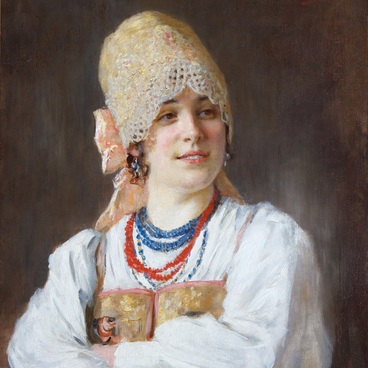Fiery Ascension of the Prophet Elijah
Creation period
End of the 18th century
Dimensions
92,5x66,4 cm
92.5x66.4x5 cm
92.5x66.4x5 cm
Technique
Wood, tempera
Exhibition
0
Open in app#1

Unknown author
Fiery Ascension of the Prophet Elijah with Scenes from his life
#3
#2
The Christian prophet Elijah is mentioned in the Old Testament. He was born 9 centuries before the birth of Jesus Christ. Christian canonical texts describe several episodes from his life.
The prophet Elijah preached at the court of King Ahab when the cult of Phoenician gods spread out, the one that glorified the god of thunder Baal and the goddess of love Astarte. Queen Jezebel also worshipped them. She invited the priests of this religion to her court and threatened Elijah with reprisals. He had to escape. After 40 days, he reached Mount Horeb and settled in a cave. According to the legend, the prophet managed to survive thanks to a crow that brought him food. It is believed that Elijah ascended to heaven in a chariot of fire.
The prophet Elijah preached at the court of King Ahab when the cult of Phoenician gods spread out, the one that glorified the god of thunder Baal and the goddess of love Astarte. Queen Jezebel also worshipped them. She invited the priests of this religion to her court and threatened Elijah with reprisals. He had to escape. After 40 days, he reached Mount Horeb and settled in a cave. According to the legend, the prophet managed to survive thanks to a crow that brought him food. It is believed that Elijah ascended to heaven in a chariot of fire.
#7
The Prophet Elijah was revered in ancient Russia. One of the first Orthodox churches in Kiev was consecrated in his honor. Elijah was especially honored in the Russian North among the Old Believers. The Prophet rose to heaven in fire, and for the Old Believers, fire was a symbol of purification. The iconographic motif of ‘Elijah the Prophet’s Fiery Ascension with Hagiographic scenes’ also appeared in the Russian North. The image was supplemented with fragments depicting Elisha, the disciple of Elijah. In the icon, the prophet throws him his mantle, a fleece cloak. Elisha hits the waters of the Jordan River with the mantle, and the waters part.
#4
Vologda icon painters
#5
The icon from the collection of the State Art Museum was painted by Vologda artists at the end of the 18th century. The icon painting school of Vologda combined the features of Novgorod and Moscow schools. Stefan Permsky and Dionysius Glushitsky, whose icons are still treasured in the temples of the Cyril-Belozersky monastery, are among the best-known Vologda icon painters.
#8
Icon
#9
The icon was painted on a wooden base after making the ark or a recess for the main image. At the edges, the icon painters left a frame. In this icon, it was painted over with dark olive paint. The upper part of the frame is decorated with Cyrillic ligature, a special decorative script in which words are combined into an ornamental pattern.
#10
State Museum of Fine Arts of Khanty-Mansiysk
read morehide
00:00
00:00
1x
Fiery Ascension of the Prophet Elijah
Creation period
End of the 18th century
Dimensions
92,5x66,4 cm
92.5x66.4x5 cm
92.5x66.4x5 cm
Technique
Wood, tempera
Exhibition
0
Open in app
Share

